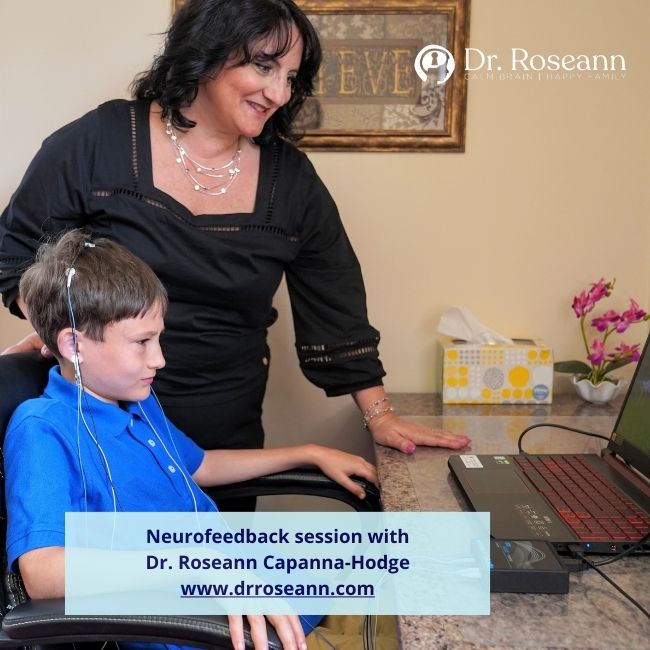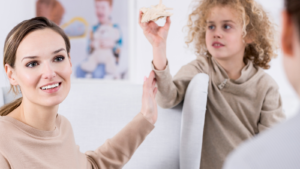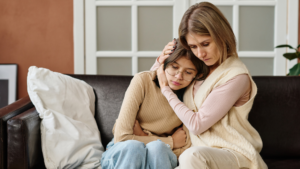How Neurofeedback Therapy Works and Helps
How Neurofeedback Works on Your Brain
Neurofeedback training can be thought of as the most effective treatment that is often unknown. This is a powerful therapy that works via operant conditioning or reinforcement and can improve a variety of symptoms associated with many different conditions.*
Through the process of neurofeedback, your subconscious gets reinforced for changing its own behavior. By reinforcing the subconscious through computers, you get visual and auditory reinforcements. Quite simply, one is reinforced for changing their brain waves at a subconscious level through the use of computers.
By creating new electrical activity through a process of measurement and reinforcement, the brain learns to self-regulate which calms the nervous system. This reduces or eliminates symptoms. Almost any brain, regardless of its level of function (or dysfunction), can be trained to function better.*
How Dysregulation Impacts the Nervous System
Dysregulation reflects an under-responsive, over responsive, or unstable nervous system. Most people are born with a pretty healthy nervous system and regulated brainwave functioning. Environmental and genetic factors do, however, impact brain wave functioning.
Some situations enhance our brain and brain waves and other more stressful ones can cause dysregulation. For example, chronic disease states, lack of sleep, chronic pain, ongoing stress, and so on are all conditions that can negatively impact functioning. When our brain wave activity is dysregulated, then negative symptoms can result.
For example, excessive stress can cause your system to be over responsive. This over responsiveness might result in difficulty turning off your thinking. The inability to turn off thoughts can make you have a hard time sleeping or give you looping thoughts. Neurofeedback allows the brain to self-regulate, which reduces negative symptoms.
Genetic issues like ADHD and depression also impact brain functioning. Whether the dysregulation results from environmental and genetic factors, Neurofeedback can reduce symptoms.
How Neurofeedback Works on a Dysregulated Nervous System
The brain is a complex organ that is made up of billions of brain cells called neurons which use electricity to communicate with each other. Each neuron uses electricity to communicate with each other and is also divided into segments that have specific neuropsychological functions. For example, the frontal lobes are in charge of preparing for actions; they are the brakes of the brain so to speak.
The combination of millions of neurons sending signals at once produces an enormous amount of electrical activity in the brain. Sensitive medical equipment, such as an EEG, can measure electricity levels over areas of the scalp. Everyone has the same brain waves, but people do not have the same pattern of brain waves.
Certain patterns are associated with specific conditions. For example, people with ADHD often have too many slow brain waves frontally (theta) and not enough fast brain waves (beta). This is what causes them to have a hard time staying focused in non-preferred areas (aka, their brain is bored!).
Without self-regulation, many problems of the central nervous system can result. Lack of focus, anxiety, depression and physical symptoms, are just a few. Neurofeedback is successfully used to treat ADHD, Autism, Anxiety, Stress, Emotional Distress, Behavioral Issues, Mood issues, Pain, Lyme, PANS/PANDAS, Headaches, Concussion, TBI and a variety of other issues. Almost any brain, regardless of its level of function (or dysfunction), can be trained to function better.
EEG Neurofeedback optimizes the brain functioning of anyone, which is why athletes and executives use it for peak performance optimization. Looking at it as a tool for brain optimization, like nutrition and exercise, we see that Neurofeedback is simply a wonderful way to improve sleep, level mood, improve focus, and improve processing speed in children and adults.
What the Research Says About How Neurofeedback Works
Four decades of research demonstrates how effective neurofeedback is (Lubar & Shouse, 1976). Current research supports that Neurofeedback improves a variety of specific issues and symptoms; everything from symptoms related to Attention-Deficit Hyperactivity Disorder or ADHD and anxiety to seizures. In 1973, when Neurofeedback was in its infancy, research was conducted to look at the effectiveness of Neurofeedback versus medication in treating Vietnam veterans with PTSD and substance abuse. Within a matter of days, the Neurofeedback was clearly eliminating symptoms and the drug company made the hospital pull the study.
Forty-five years later, medication is still being pushed by Western medicine as the only solution for mental health issues. Somehow people have been convinced that medication is more effective and safe, but that couldn’t be further from the truth.
Research (Khajehpiri et al., 2014 and Swanson et al., 2017) demonstrates numerous side effects of the common medication used to treat ADHD, methylphenidate, including: cardiovascular events, seizures and strokes (can be long-term), tics, obsessive-compulsive behavior, anorexia, irritability, psychosis and mania, depression (can be long-term), insomnia, slowed and reduced growth, elevated blood pressure, and drug abuse.
Recent meta-analyses document the effectiveness of Neurofeedback in the treatment of ADHD (Arns, de Ridder, Strehl, Breteler, and Coenen, 2009) in reducing inattention, impulsivity, and hyperactivity. In another study, Ziong, Shi and Hu (2005) demonstrated a 90 percent of children with ADHD improved after 40 sessions of Neurofeedback.
In 2012, the American Academy of Pediatrics rated Neurofeedback/ Biofeedback is rated as a Level 1 intervention for ADHD which is the same level as medication. This was a verification of the effectiveness of Neurofeedback as an effective holistic therapy.
Despite all the positive research, traditional allopathic medicine hasn’t embraced Neurofeedback which keeps it from becoming mainstream. Even most physicians and mental health practitioners don’t know enough about it. This is due to a lack of education and training about how neurofeedback works and how effective it is.
Even therapists have been trained to recommend medication when they should recommend a multitude of other therapies (Neurofeedback, Biofeedback, EFT, EMDR, hypnosis, diet, meditation, yoga, etc.) that calm the nervous system in a manner that creates space for people to experience their emotions and then address them in therapy.
There really are few therapies that have has as much positive research as neurofeedback. Yet, neurofeedback hasn’t become mainstream. With traditional medicine not supporting it, many people don’t trust it. Research from Gani et al. (2008) demonstrates the long-term effectiveness of Neurofeedback, as they found that improvements in behavior and attention were stable 6 months and 2 years after completion of therapy.
Neurofeedback produces lasting changes that puts people on a path to wellness and people need to see it for what it is: a research tested, valid and safe option for improving brain functioning and mental health.
The Neurofeedback Process
The first step is getting a quantitative EEG (QEEG). A cap is placed on one’s head and surface electrical activity that the brain produces is measured. In very simple terms, QEEG is a computer analysis of the EEG data; it is a procedure where EEG activity is recorded and statistically analyzed and your data is compared against a database to look for patterns that highlight what areas are over or underworking. It is a visual way to see brain functioning in terms of brain waves.
After a QEEG, a neurofeedback protocol is personally designed by Dr. Roseann that focuses on calming and regulating the brain, so a person can focus, feel calm and not so moody, as well as sleep better.
Depending on the condition, issues, and brain functioning, the number of EEG Neurofeedback sessions required vary based on each individual but range from 20 to 100 or more sessions. Most clients need to come in two to three times a week in order to see lasting change. Like exercise, it requires one to commit to the process and come in regularly to “build the muscle.”. While the research shows us that the majority of people report symptom reduction, some see changes quickly and others take time to see the difference.
Every practitioner measures in different ways, but most collect data after every session. It’s important to understand that the science behind neurofeedback incorporates regular data collection.
At our office, we monitor progress in three ways. First, QEEGs at regular intervals allow us to objectively look at brain functioning. Second, data collection occurs at every Neurofeedback session. Third, we regularly customize protocols through checklist progress monitoring.
Neurofeedback impacts brain waves because one is reinforced for changing their own brainwaves and maintaining a healthy focused and calm rhythm. Typically a person pushes down a brainwave of which they have too much and increases one of which they don’t have enough. This results in reducing a person’s symptoms and an improvement in attention, memory, and mood. Each person’s protocol is different based on what their issues are and their brain wave patterning.
Many people mistakenly think that Neurofeedback equipment manipulates something. What really occurs is that the machines simply help people increase their ability to manage their own brain. They learn to strengthen their own neural circuits through the simple process of reinforcement.
How Neurofeedback Works Differently From Medication
Neurofeedback is completely different because it serves to calm the central nervous system and at the same time enhance positive qualities. It gets the CNS to self-regulate so that negative symptoms dissipate. One often feels calm yet focused, sleep improves, and one’s overall mood is enhanced. Once the brain has learned healthy patterns, it will continue operating in a healthy manner once you have stopped.
One mom called her kid, “Johnny 2.0” after doing Neurofeedback because she said the Neurofeedback just made him a better version of himself. She articulated so beautifully what happens to adults and kids after Neurofeedback all the time. They become a better version of themselves because their brain can self-regulate.
Our office has had children who are able to color for the first time and adults who stop being anxious after Neurofeedback. One mother shared that after only twelve sessions, her 9-year-old son could sit a play a board game for the first time in his life. Recently, an adult was able to focus for the first time after unsuccessfully trying 12 medications. When you get the nervous system to self-regulate, the positive change can be quite dramatic or more subtle and take time.
The other major benefit of Neurofeedback is that there are so few side effects whereas with medication there are many. Neurofeedback also works synergistically with other holistic therapies and treatments.
Shockingly one-third of all hospital admissions are due to medication side effects. Horribly, this wastes money wasted and causes unneeded suffering. With all the side effects associated with medications and a lack of long-term effectiveness (Jensen et al., 2007), people need to learn about the effectiveness of research-based therapies like Neurofeedback and understand the reasons why they shouldn't medicate their kids and potentially negatively impact a developing brain.
Side Effects of Neurofeedback
Many people have questions about neurofeedback but if there are side effects is a big one we often here. Because of how neurofeedback works, there are few, if any, side effects.
Certain types of brainwave patterning are associated with a higher rate of temporary reactions, and your experienced practitioner should know how to address that. In addition, an experienced practitioner who is doing their own QEEG’s can alter the Neurofeedback in real time to address any overstimulated or understimulated responses.
Over-stimulated responses can make a person hyper, give them a headache or cause them to become irritated. On the other hand, it can cause them to be under-stimulated which shows in the form of being tired. A simple protocol adjustment will stop any temporary side effects.*
What to Look for in a Neurofeedback Provider
Most practitioners use EEG Neurofeedback. How neurofeedback works is not related to any type of equipment or program compared to another. What makes one treatment better than another is the quality and experience of the practitioner and it is important to know that neurofeedback is largely determined by the quality of the practitioner, which is why you want work with Dr. Roseann.
No matter where you are in the world, you can work with Dr. Roseann from the comfort of your home with at home neurofeedback.
What is neurofeedback therapy?
Neurofeedback therapy, a type of brain wave therapy, utilizes EEG neurofeedback to help individuals learn to regulate their brain activity for better function and mental health.
How does neurofeedback training work?
Neurofeedback training works by allowing individuals to respond to real-time feedback based on their EEG, facilitating the learning of self-regulation of brain waves.
Can I find a neurofeedback therapist near me?Yes, you can find a neurofeedback therapist near you by searching professional directories or contacting local neurotherapy treatment centers.
What potential side effects might I experience with neurofeedback?
While neurofeedback is considered safe, some individuals may experience mild side effects such as temporary fatigue or mild headaches post-session.
Is neurofeedback safe for children and adults?
Neurofeedback is generally safe for both children and adults, but it’s essential to consult with a healthcare provider to ensure it's appropriate for your specific health condition.
Can neurofeedback treatment help with ADHD?
Yes, neurofeedback has shown effectiveness in reducing symptoms of ADHD by training the brain to increase focus and reduce impulsivity.
How does neurofeedback compare to traditional EEG therapy?
Unlike traditional EEG therapy, which is diagnostic, neurofeedback uses EEG readings for real-time brain training to improve cognitive and emotional health.
What is the primary goal of neurofeedback?
The primary goal of neurofeedback is to improve brain self-regulation, which can lead to enhanced cognitive performance and mental health.
Are there different types of neurofeedback?
There are various types of neurofeedback, including EEG and IFS, and neurofeedback protocols, including amplitude and frequency training, each designed to address specific brain activity patterns.
Is neurofeedback therapy covered by insurance plans?
Insurance coverage for neurofeedback therapy varies, so it's crucial to check with your insurance provider to understand your coverage.
How much does neurofeedback therapy typically cost?
The cost of neurofeedback therapy varies by region and clinic, with prices ranging based on the number of sessions required.
Can neurofeedback be effective for treating anxiety?
Neurofeedback has been used effectively to manage symptoms of anxiety by training the brain to maintain calmer and more stable patterns.
What can I expect during a neurofeedback session?
During a neurofeedback session, sensors are placed on your scalp to monitor brain activity, and you're guided through exercises that provide feedback based on your brain wave patterns.
How is neurofeedback different from biofeedback?Neurofeedback focuses specifically on brain activity, while biofeedback may involve other physiological processes, such as heart rate or muscle tension.
Can I perform neurofeedback therapy at home?With advancements in technology, there are home neurofeedback devices available, but it's recommended to use them under the supervision of a professional such as in our BrainBehaviorReset™ Program.
What role does neurofeedback play in brain mapping?Neurofeedback utilizes brain mapping to identify specific areas of the brain for targeted training, improving areas such as focus and emotional regulation.
Is there substantial research supporting neurofeedback therapy?
Numerous studies have supported the effectiveness of neurofeedback, especially for conditions like ADHD, anxiety, and sleep disorders.
Are there neurofeedback devices designed for home use?
There are now neurofeedback devices available for home use, but professional guidance is advised to ensure proper use and effectiveness.
What is the purpose of brain mapping therapy in neurofeedback?
Brain mapping therapy in neurofeedback helps to identify and target specific brain regions that may benefit from training to enhance overall brain function.
What qualifications should I look for in a neurofeedback practitioner?
Look for a neurofeedback practitioner with proper certification, experience, and a good track record of success with clients.
How effective is neurofeedback for managing depression?
Neurofeedback has shown promise in managing depression by helping individuals regulate brain patterns associated with mood.
Can neurofeedback be used to improve cognitive performance?Neurofeedback is used to enhance cognitive performance, including memory, focus, and processing speed, by training the brain to function more effectively.
What are the differences between neurofeedback and biofeedback?
The main difference lies in their focus: neurofeedback targets the brain's electrical activity, while biofeedback may address other physiological responses.
Can neurofeedback be beneficial for conditions other than ADHD and anxiety?
Neurofeedback is also beneficial for conditions like depression, autism, PTSD, OCD, sleep disorders, and cognitive impairments due to its regulatory effects on brain activity.
What are the long-term effects of neurofeedback therapy?
Long-term effects of neurofeedback therapy are generally positive, contributing to sustained improvements in brain function and symptom reduction.
How does neurofeedback therapy improve brain function in healthy individuals?
In healthy individuals, neurofeedback therapy can enhance brain function by optimizing neural pathways and reinforcing effective brainwave patterns.
What indications suggest neurofeedback is working effectively?
Improvements in the targeted symptoms, such as better focus, reduced anxiety, or improved sleep, indicate effective neurofeedback training.
How does neurofeedback compare to traditional medication for ADHD?
Neurofeedback provides a non-pharmacological alternative to traditional medication, potentially reducing the need for long-term medication use in ADHD treatment.
What are the necessary qualifications for a neurofeedback practitioner?
A neurofeedback practitioner should have appropriate training, certification, and experience, along with knowledge of EEG interpretation and neurofeedback protocols.
Is neurofeedback recognized as a legitimate therapy?
Neurofeedback is recognized as a legitimate therapy by professionals in the field, especially for conditions like ADHD, and is supported by research. It is also an effective non-medication therapy that can help a brain self regulate.
Always remember… “Calm Brain, Happy Family™”
Are you looking for SOLUTIONS for your struggling child or teen?
Dr. Roseann and her team are all about solutions, so you are in the right place!
There are 3 ways to work with Dr. Roseann:
You can get her books for parents and professionals, including: It’s Gonna Be OK™: Proven Ways to Improve Your Child’s Mental Health, Teletherapy Toolkit™ and Brain Under Attack: A Resource For Parents and Caregivers of Children With PANS, PANDAS, and Autoimmune Encephalopathy.
If you are a business or organization that needs proactive guidance to support employee mental health or an organization looking for a brand representative, check out Dr. Roseann’s media page and professional speaking page to see how we can work together.
Dr. Roseann is a Children’s Mental Health Expert and Licensed Therapist who has been featured in/on hundreds of media outlets including The Mel Robbins Show, CBS, NBC, PIX11 NYC, Today, FORBES, CNN, The New York Times, The Washington Post, Business Insider, Women’s Day, Healthline, CNET, Parade Magazine and PARENTS. FORBES called her, “A thought leader in children’s mental health.”

She coined the terms, “Re-entry panic syndrome” and “eco-anxiety” and is a frequent contributor to media on mental health.
Dr. Roseann Capanna-Hodge has three decades of experience in working with children, teens and their families with attention-deficit hyperactivity disorder (ADHD), autism, concussion, dyslexia and learning disability, anxiety, Obsessive Compulsive Disorder (OCD), depression and mood disorder, Lyme Disease, and PANS/PANDAS using science-backed natural mental health solutions such as supplements, magnesium, nutrition, QEEG Brain maps, neurofeedback, PEMF, psychotherapy and other non-medication approaches.
She is the author of three bestselling books, It’s Gonna Be OK!: Proven Ways to Improve Your Child's Mental Health, The Teletherapy Toolkit, and Brain Under Attack. Dr. Roseann is known for offering a message of hope through science-endorsed methods that promote a calm brain.
Her trademarked BrainBehaviorResetⓇ Program and It’s Gonna be OK!Ⓡ Podcast has been a cornerstone for thousands of parents facing mental health, behavioral or neurodevelopmental challenges.
She is the founder and director of The Global Institute of Children’s Mental Health, Neurotastic™Brain Formulas and Dr. Roseann Capanna-Hodge, LLC. Dr. Roseann is a Board Certified Neurofeedback (BCN) Practitioner, a Board Member of the Northeast Region Biofeedback Society (NRBS), Certified Integrative Mental Health Professional (CIMHP) and an Amen Clinic Certified Brain Health Coach. She is also a member of The International Lyme Disease and Associated Disease Society (ILADS), The American Psychological Association (APA), Anxiety and Depression Association of America (ADAA) National Association of School Psychologists (NASP), International OCD Foundation (IOCDF).
© Roseann-Capanna-Hodge, LLC 2024
Disclaimer: This article is not intended to give health advice and it is recommended to consult with a physician before beginning any new wellness regime. *The effectiveness of diagnosis and treatment vary by patient and condition. Dr. Roseann Capanna-Hodge, LLC does not guarantee certain results.















